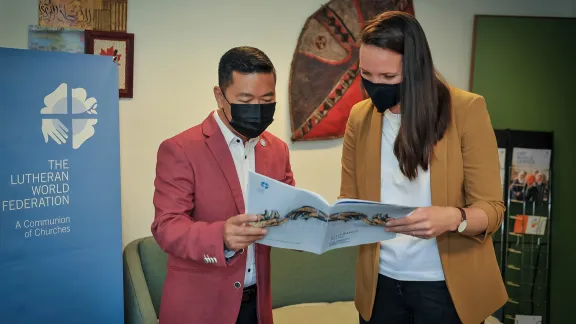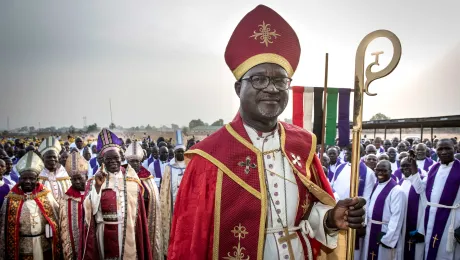
The publication was put together by Ms Marina Dölker (right) LWF Program Executive for Diakonia and Development and Mr Allan Calma (left), World Service Global Humanitarian Coordinator. Photo: LWF/S. Gallay
Interview with co-editors of LWF guidelines on collaboration of member churches and World Service
(LWI) - The Lutheran World Federation (LWF) recently launched new guidelines on collaboration between its member churches and the communion’s humanitarian and development arm, World Service. The Guidance Note: Joint Engagement of World Service Programs and Member Churches underlines and shows how to deepen engagement and strengthen networking at the local level. It is also offered as a resource for other churches and faith-based organizations.
The Guidance Note was jointly developed by Ms Marina Dölker, LWF Program Executive for Diakonia and Development in the Department for Theology Mission and Justice and Mr Allan Calma, LWF World Service Global Humanitarian Coordinator. In this interview, they explain the publication’s purpose, its target groups, how to use it, and how it will be distributed in the LWF.
Collaboration between LWF’s member churches and World Service programs is not new, why was it necessary to develop the ‘Guidance Note’?
Dölker: Yes, it is true that collaboration between member churches and World Service programs is not new. In the past, support has been provided through strengthening their joint engagement, for example in the context of the Churches and Emergencies initiative. At the same time, World Service and church representatives have expressed the need for more general orientation on how they can work together and deepen collaboration.
Stronger and more consistent engagement between LWF member churches and World Service emergency and country programs presents a concrete opportunity for positive change and greater impact.
Calma: Indeed, this is not new and, in most cases, World Service responds to an emergency upon the request of a member church. Most frequently the initial response involves close collaboration between the two, but it varies from context to context. In this respect, the Guidance Note is a collection of good practices that could inspire new ways of engagement, which is precisely the purpose of this publication. Whenever appropriate, stronger and more consistent engagement between member churches and World Service emergency and country programs presents a concrete opportunity for positive change and greater impact.
What makes collaboration thrive?
Dölker: LWF member churches and World Service are different parts of the same body. As such, they share the same Christian values that are at the heart of the LWF: dignity and justice, compassion and commitment, respect for diversity, inclusion and participation, transparency and accountability. Ultimately, both World Service and member churches aim to build a more just, peaceful, and reconciled world.
Calma: Both aim to provide a practical witness of God’s love for those who are suffering and marginalized and this can be seen clearly in the work that both do. Although member churches are present in more countries (99 countries) than World Service (25 countries), in cases where both are present, this overlap is definitely one of the most obvious similarities which also offers potential for greater collaboration. Consequently, if we are both present in the same public space, then we are confronted with the same context and challenges. In such cases, it will be beneficial for us to collaborate and hopefully find solutions to our common concerns.
What makes the work of member churches different from that of World Service?
Dölker: World Service and member churches have distinct mandates. Member churches engage in diaconal work as part of their holistic mission, whereas the mandate that the churches have given to World Service is focused on international diakonia and advocacy. As a result, the working modalities and the language that each uses to describe their work can look very different. World Service staff tend to use humanitarian terminology to talk about their work. Churches explain their diaconal work using biblical references and theological concepts. But there are also differences between different churches: some churches run big diaconal institutions whose working modalities can look quite similar to the way World Service programs operate.
Calma: The distinct mandates are definitely the key difference, but misunderstanding often happens mainly due to a lack of comprehension about this distinction. I would highly recommend that World Service programs and member churches invest time and effort in understanding each other’s context. An open dialogue about our respective mandates and what this entails will go a long way in strengthening our relationship and possibly also contribute toward mutual learning.
Which are some of the existing models and good practices highlighted in the publication?
Calma: Four case studies are included in this publication where the readers can learn more about the good practices in Angola, Colombia, Myanmar, Nepal and Venezuela. What is interesting about these case studies is that they highlight good practices from relationships that started in the 1980s to relatively new ones, as recently as 2019. The stories are shared from the perspective of those in the frontlines and tell of achievements in multilateral and joint action as well as cross-border responses. The backdrop of these case studies also ranges from a Christian context to a multi-religious context. The stories are honest and do not shy away from discussing specific challenges and risks faced. A key lesson the reader will notice across the case studies is that collaboration is a mutual process in which building trust takes time and commitment from both sides. But it all starts with a simple small step—sometimes as simple as enjoying a cup of tea together.
What practical advice is offered to a member church and World Service program that are interested in working jointly for the first time or thinking of reviewing their existing collaboration?
Dölker: As Allan mentioned before, collaboration starts with cordial relationships. Inviting a group of leaders from the church or World Service program to a joint meeting, lunch or dinner for a conversation about each other’s work is a great entry point to discover common ground. There may be some key events or celebrations where church or World Service representatives can be invited to share about their work and future plans. These kinds of invitations are a good starting point from where actual collaboration can grow. A next step could be to explore the possibility of a joint training or even a small joint project, which can be a great opportunity for mutual learning, involving also personnel beyond the leadership level. Examples show that it is important to have an honest conversation about mutual expectations, roles and responsibilities and also possible limitations before starting a joint project. Developing a Memorandum of Understanding together can help to clarify those questions and formalize the relationship.
The cover shows two hands, what does this symbolize?
Dölker: The two hands illustrate the journey of joint engagement and collaboration—a journey that is marked by giving and receiving. At times we find ourselves at the giving end, other times at the receiving end. There is much that churches can learn from Word Service programs and much that World Service programs can learn from churches. The Guidance Note is about opening up ourselves for that kind of mutual learning and sharing.
Calma: As one can imagine, this cover has already sparked interesting conversations among colleagues as it could be interpreted in different ways. For example, the rights-based empowerment approach of the work of World Service moves away from the concept of just giving and receiving. But we feel that the cover and how this image reflects the realities in the respective contexts could be a great entry point for discussions during the planned regional consultations.
How will the publication be rolled out?
Calma: The first step is to print and distribute the document among LWF staff in the Communion Office, the World Service country and emergency programs, and the member churches. We will then facilitate regional roll-out workshops where LWF staff and church representatives can come together to discuss how they plan to use the resource.
We are also encouraging everyone to be more intentional in identifying progress in our engagements and in collecting good examples to share.
Dölker: We are also encouraging everyone to be more intentional in identifying progress in our engagements and in collecting good examples to share. Finally, and as a practical step, we do encourage the use of this Guidance Note during the induction of new World Service staff and newly elected church leaders.
World Service is the humanitarian and development arm of the LWF, seeking to bring people of all backgrounds together in the common quest for justice, peace, and reconciliation. It is a widely recognized, international, faith-based organization working through country and emergency programs in 25 countries that support nearly 3 million people in need each year.
The 148 LWF member churches represent more than 77 million Christians in the Lutheran tradition in 99 countries across the globe. As a global communion of churches, the member churches live and work together for a just, peaceful, and reconciled world.


